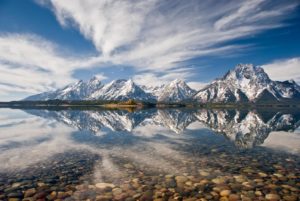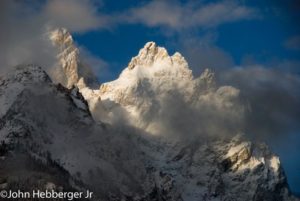Archive of Steve's Blog
Interesting Posts from the Past2016
Knowing this, we at GJH tip our hats to all of the earth scientists within and without our organization who strive to raise public awareness and better understanding of the danger presented by the Teton Fault. This Tuesday, (June 21st) at the Teton County Library Auditorium at 6:00 pm we get to hear about the Teton Fault from University of Pittsburg and Occidental College Post-Doctorate researcher Darren Larsen. Dr. Larsen has turned his attention to the sediments at the bottom of the lakes that dot the east side of our passive-aggressive fault. These sediments constitute a new lens through which we can look back thousands of years for more discriminating information about the frequency and strength of Teton Fault earthquakes. When was the last quake? How big was it? Are we overdue for another? This is one of those subjects that touch all of us living near the fault. We hope to see many of you Tuesday.
2015

Leftover fruitcake from 2013. These structures are frequently lithified during the holiday season and are generally durable enough to be re-gifted the following year.
January 2014.
A DEVONIAN CATASTROPHE
The Devonian period was a golden age full of all the promises and possibilities of youth. It is even now – all these years later – credited with several significant “firsts.” Seed bearing plants first spread across the land in the Devonian, and by the end of that period great forests were commonplace. The Devonian was the first period to witness tetrapods walking across dry ground. The continent of Laurasia (Euramerica) was formed in the Devonian and was fast on its way to an urgent rendezvous with Gondwana. (Their shotgun marriage in the Permian gave rise to the great supercontinent Pangea and their inevitable divorce produced the Atlantic ocean.) The Devonian is sometimes referred to as the “Age of Fish” because of the explosive increase in diversity in the Devonian species inventory. Much came to be in the Devonian, and that which was already there became more complex, bigger, stronger, or faster. But the tale ends unwell. The Late Devonian was forever besmirched by one of the top five extinction events in the earth’s history. And this of course begs the biggest of questions: Why?
Fast-forward to January, 1990. A Colorado School of Mines graduate student and a UNOCAL petroleum geologist were poking around in Southern Nevada when they noticed a gravelly limestone breccia that seemed a little “off.” While Nevada is full of limestone – and therefore full of carbonate breccias – this particular outcrop did not belong in the Devonian formation in which it occurred. A couple days later, with CSM professor John Warme at their side, the intrepid geologists found another breccia outcrop of equivalent age some 30 kilometers eastward, this one bearing fragments several meters across. Due to the discovery of shocked quartz grains, and several field trips and graduate students later, the scientific community had finally warmed up to the idea that this locally ubiquitous breccia was the product of a massive impact. Found all over Southern Nevada, including near the town of Alamo, the breccia was named the Alamo Breccia by Professor Warme, who thought it a “catastrophically fitting” title.
2013-2014
February 2013 GTNP
I am a science fan. While it is not nearly as empirical a pursuit as some think, it is at least a place where observations are measurable in units of relative consistency. A calorie is the amount of energy needed to raise the temperature of one gram of water by one degree C at 1 atmosphere pressure. A second – originally defined in relation to a mean solar day – is usually defined in relation to atomic decay. Thus we have the “atomic clock,” an incredibly precise yardstick for observations that concern the passage of time. And while even the atomic clock can lose some utility when examined in the rarified realm of quantum physics, a second will always be 1/60th of a minute, and will, for practical purposes, always represent the same amount of time. A millimeter will always represent the same distance, a calorie the same heat/energy, and so forth.
I find comfort in knowing that there are things that you can always count on because in my line of work nothing is certain. The yardsticks employed in the practice of law are as consistently variable as human nature itself. It is an arena where words have any number of meanings and truth is what the jury says it is. Still, our comfort with ambiguity and our ability as a species to function in an environment where little is certain has honed perhaps one of our greatest strengths – the ability to create ideas. The U.S. Constitution. Ivanhoe. Beethoven’s Fifth Symphony.
I make this argument because we geology buffs are predisposed to regard Grand Teton National Park as the end product of a chain of different geologic processes over the last 2.8 billion years. These natural (and measurable) forces conspired to deliver to our back yards what is in my mind the finest monument to creation anywhere in the world. The thing is, the Tetons exist independently of the status we accord them. They are young, but still millions of years older than the Park. So when we talk about “the Park,” what we are really talking about is not the mountains, but rather the idea that the Tetons are worth preserving and protecting. For everyone.
The idea of a National Park eventually prevailed, but this was never a guaranteed outcome. This Tuesday GJH member Wayne Johnson is going to give us the back-story. In much the same way that John Willott and John Hebberger can describe how the Tetons were built, Wayne is going to tell us how the Park was built. As only he can, he will present the park as a struggle for an idea. A grand idea, but one that many good people opposed. And in his colorful and deeply insightful narrative you will undoubtedly find many lessons that are relevant to our responsibility as the stewards of not just a physical place, but also of an idea about that place.


